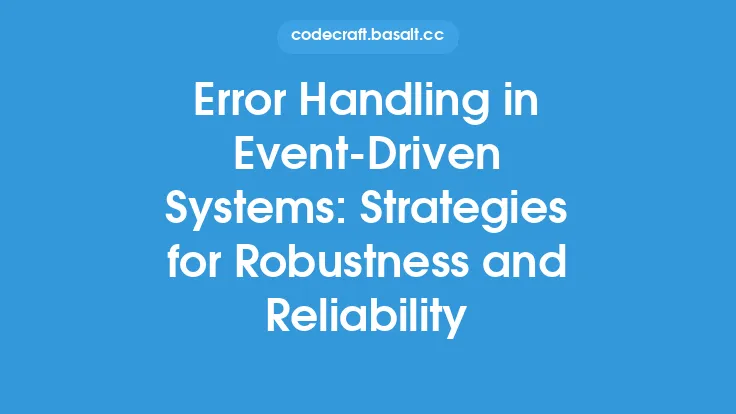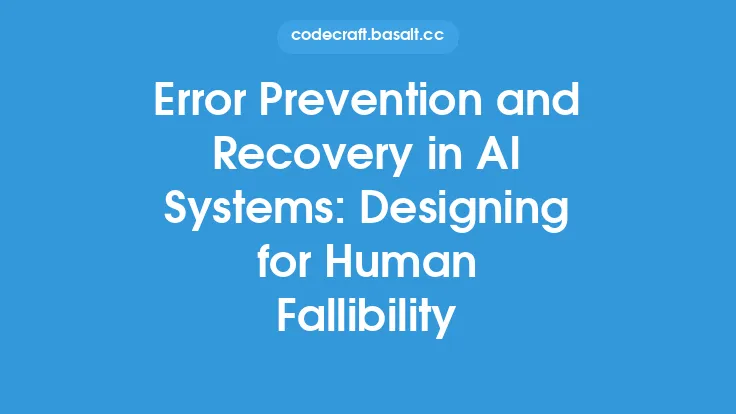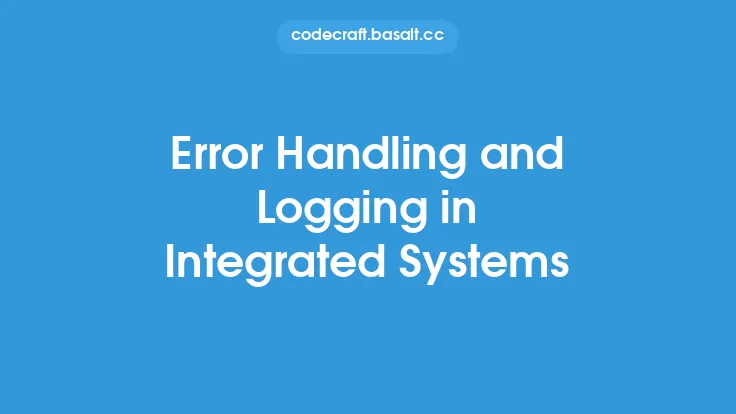Event-driven systems have become increasingly popular in recent years due to their ability to provide scalability, flexibility, and loose coupling. However, as with any complex system, errors can and will occur. Error handling and recovery are crucial aspects of event-driven systems, as they can have a significant impact on the overall reliability and performance of the system. In this article, we will delve into the world of error handling and recovery in event-driven systems, exploring the challenges, strategies, and best practices for building robust and resilient systems.
Introduction to Error Handling in Event-Driven Systems
Error handling in event-driven systems is more complex than in traditional request-response systems. In event-driven systems, events are published and consumed by multiple services, making it challenging to identify and handle errors. When an error occurs, it can be difficult to determine the source of the error, and the error can propagate through the system, causing further issues. Furthermore, event-driven systems often involve asynchronous communication, which can make it harder to handle errors in a timely and effective manner.
Types of Errors in Event-Driven Systems
There are several types of errors that can occur in event-driven systems, including:
- Event production errors: These errors occur when an event is not produced correctly, such as when an event is not serialized correctly or when an event is not published to the correct topic.
- Event consumption errors: These errors occur when an event is not consumed correctly, such as when an event is not deserialized correctly or when an event is not processed correctly.
- Event processing errors: These errors occur when an event is being processed, such as when a service fails to process an event or when a service throws an exception while processing an event.
- Network errors: These errors occur when there are issues with the network, such as when a service is unable to connect to the event broker or when a service is unable to send or receive events.
Strategies for Error Handling in Event-Driven Systems
There are several strategies for error handling in event-driven systems, including:
- Retry mechanisms: Implementing retry mechanisms can help to handle transient errors, such as network errors or temporary service failures.
- Dead letter queues: Using dead letter queues can help to handle events that cannot be processed, such as when an event is not in the correct format or when an event is not valid.
- Error topics: Using error topics can help to handle events that fail processing, such as when a service throws an exception while processing an event.
- Idempotent events: Designing events to be idempotent can help to handle errors, such as when an event is processed multiple times or when an event is not processed at all.
Best Practices for Error Handling in Event-Driven Systems
There are several best practices for error handling in event-driven systems, including:
- Monitor and log errors: Monitoring and logging errors can help to identify issues and debug problems.
- Implement error handling mechanisms: Implementing error handling mechanisms, such as retry mechanisms and dead letter queues, can help to handle errors and prevent them from propagating through the system.
- Design for failure: Designing for failure can help to handle errors, such as when a service fails or when a network error occurs.
- Test for errors: Testing for errors can help to identify issues and ensure that error handling mechanisms are working correctly.
Recovery in Event-Driven Systems
Recovery in event-driven systems is critical to ensuring that the system can recover from errors and continue to operate correctly. There are several strategies for recovery in event-driven systems, including:
- Event replay: Event replay involves replaying events that were not processed correctly, such as when a service fails or when a network error occurs.
- Event reprocessing: Event reprocessing involves reprocessing events that failed processing, such as when a service throws an exception while processing an event.
- Service restart: Service restart involves restarting a service that failed, such as when a service crashes or when a service is not responding.
Tools and Technologies for Error Handling and Recovery
There are several tools and technologies that can help with error handling and recovery in event-driven systems, including:
- Apache Kafka: Apache Kafka is a popular event broker that provides features such as retry mechanisms and dead letter queues.
- Amazon SQS: Amazon SQS is a message queue service that provides features such as retry mechanisms and dead letter queues.
- RabbitMQ: RabbitMQ is a message broker that provides features such as retry mechanisms and dead letter queues.
- Event-driven frameworks: Event-driven frameworks, such as Apache Camel and Spring Cloud Stream, provide features such as error handling and recovery mechanisms.
Conclusion
Error handling and recovery are critical aspects of event-driven systems, as they can have a significant impact on the overall reliability and performance of the system. By understanding the challenges and strategies for error handling and recovery, developers can build robust and resilient event-driven systems that can handle errors and continue to operate correctly. By following best practices, such as monitoring and logging errors, implementing error handling mechanisms, designing for failure, and testing for errors, developers can ensure that their event-driven systems are reliable and performant.





